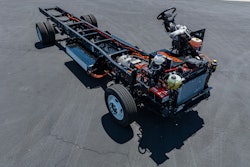Trucking news and briefs for Tuesday, May 2, 2023:
Truckload shipments fall more than 6% in Q1
The volume of freight shipments moved via truck declined in the first quarter of 2023 by 6.1% year-over-year, according to the latest U.S. Bank Freight Payment Index – the fourth consecutive quarter where volume has contracted on an annual basis.
The drop was most intense in the Southeast, West and Northeast regions, where volume fell 16.1%, 14.1% and 13.8%, respectively. Shipments fell just 2.4% year-over-year in the Midwest, but the region has experienced contracting volume for 12 straight quarters. Meanwhile, shipments in the Southwest region increased 14%, the region’s largest year-over-year increase since early 2018.
“This quarter was a prime example of how important it is to examine regional data when assessing truck freight shipments in the U.S.,” said Bobby Holland, director of freight data solutions at U.S. Bank. “Boosted by growing truck-transported trade with Mexico and increased activity at the Port of Houston, truck freight activity in the Southwest region is markedly different than what we’re seeing in other regions.”
Nationwide spending on truck freight fell just 0.3% year-over-year driven by an 8% year-over-year spending drop in the Midwest. Spending rose in all other regions, including by 16.7% annually in the Southwest and 7.8% in the Southeast.
Bob Costello, senior vice president and chief economist at the American Trucking Associations, noted that the spending data seen in the South is more evidence that there is real trucking supply tightness there, while the Midwest is experiencing the opposite.
Regional Data
West
Shipments
Linked quarter: -2.8%
Year over year: -14.1%
Spending
Linked quarter: 6.9%
Year over year: 2.8%
Shipments declined in the West on a quarterly basis for the fourth consecutive quarter. Low seaport volumes and a significant contraction in housing starts appear to be impacting truck freight volumes in the region.
Southwest
Shipments
Linked quarter: 5.0%
Year over year: 14.0%
Spending
Third quarter: 5.7%
Year over year: 16.7%
Continuing to be the top region for truck freight, the Southwest experienced its eighth straight quarter of year-over-year volume and spending increases.
Midwest
Shipments
Linked quarter: 1.3%
Year over year: -2.4%
Spending
Linked quarter: -5.3%
Year over year: -8.0%
The region continues to be the weakest overall, notching its 12th-straight year-over-year contraction in volume. There appears to be ample truck capacity in the Midwest, which was the only region to have a drop in spending.
Northeast
Shipments
Linked quarter: -4.8%
Year over year: -13.8%
Spending
Linked quarter: 2.2%Year over year: 2.0%
This was the third-straight year-over-year decline in volume in the region and the largest drop since Q1 2021. Spending increased even as diesel fuel prices fell, suggesting marginally constrained capacity in the area.
Southeast
Shipments
Linked quarter: -10.1
Year over year: -16.1%
Spending
Linked quarter: 1.8%
Year over year: 7.8%
The Southeast had the largest annual decline among all regions, with the 16.1% drop the largest on record for the region. Similar to the West, new housing starts and declining seaport activity appear to be impacting truck freight volume in the Southeast.
BAE Systems, Eaton collaborate on electric drive
Eaton announced Monday it will collaborate with BAE Systems, a developer of electric propulsion systems to develop electric vehicle (EV) technology solutions.
As part of the collaboration, BAE Systems will incorporate its power-dense electric motor and advanced silicon carbide/gallium nitride power electronics suite with Eaton’s MD 4-speed EV transmission. The companies will initially offer a solution for the medium-duty commercial truck platforms market, and a Class-7 pickup and delivery demonstration vehicle in currently under development.
BAE Systems has more than 16,000 propulsion systems operating worldwide in transit buses, boats, and military and industrial vehicles across the globe. Its electric propulsion technology is developed and serviced at its facilities in Endicott, New York and Rochester, U.K.
Bosch, Plus collaborate on hardware, software
Bosch and autonomous truck developer Plus have reached a technology agreement that calls for Plus to offer its PlusDrive solution with the integrated steering system from Bosch, featuring hardware and software to deliver driver assistance and partially automated features to commercial vehicles.
PlusDrive-enabled L2++ vehicles are equipped with a predictive 360-degree surround perception system and provide partial automation by continuously helping drivers with acceleration, braking and steering. The PlusDrive software-based system and the Bosch hardware plus software steering solution work together to enable assisted driving and automated functions. PlusDrive provides traffic jam assist, merge handling, driver-initiated and suggested lane change, over-the-air updates, lane nudge, sensor self-calibration, driver attentiveness detection, and other highly automated driving features. When combined with Bosch’s steering system for lateral control, its benefits include driver retention, fuel economy savings and assistance capabilities to help reduce accidents, the companies claim.
Colorado passes zero emission truck regs
The state of Colorado late last week joined California in approving rules designed to encourage the use of zero-emission vehicles. The Mile High State's set of regulations are considerably less restrictive than those passed Friday on the West Coast, which requires all new medium- and heavy-duty vehicles sold or registered in the state to be zero-emission by 2036 and requires all trucks to be zero-emission by 2042.
The Colorado Air Quality Control Commission on April 28 approved a plan that would convert most of the medium- and heavy-duty trucks sold in the state to zero emission beginning in 2027. The state's goal is to have 40% of all medium- and heavy-duty trucks sold in the state be powered by zero-emission engines by 2035. The new regulation, however, does not require that companies purchase zero-emission vehicles. They only require manufacturers to make the trucks available for sale.











